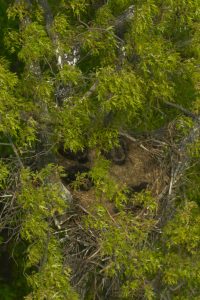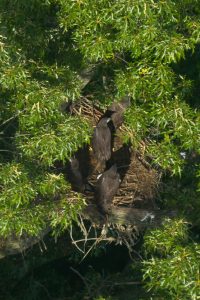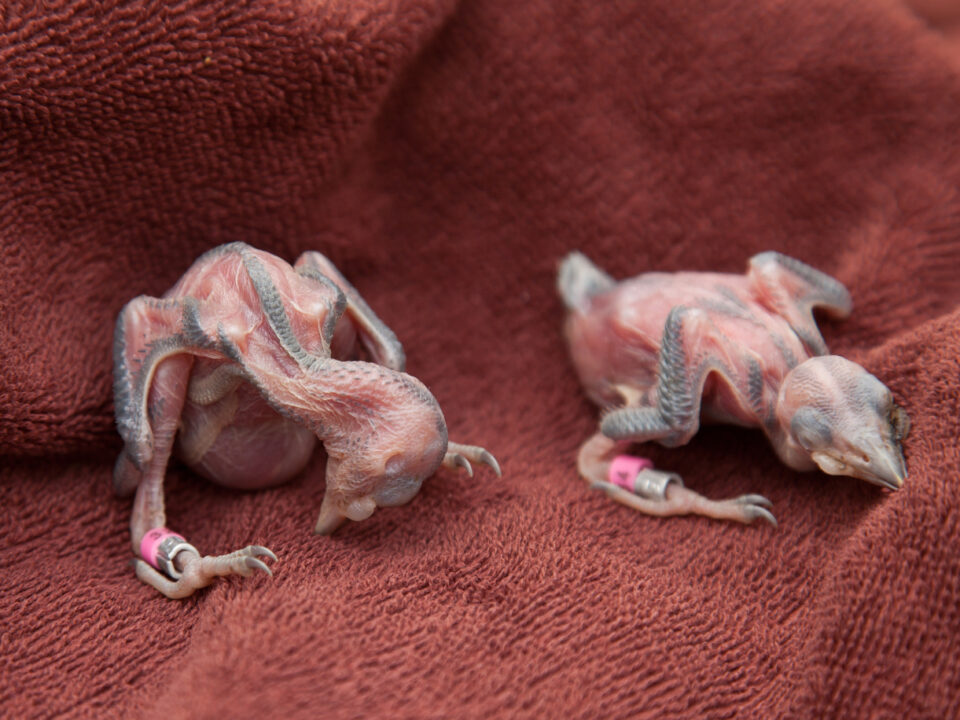Rare four-chick eagle brood in Pennsylvania
Mexican whip-poor-will monitoring
July 10, 2010Camellia Remains at NBG
July 12, 2010
Written by Bryan Watts
July 11, 2010
For bald eagles (Haliaeetus leucocephalus), brood size typically varies between one and three and geographic patterns in both average brood size and proportion of three-chick broods are believed to vary with prey abundance. Bald eagle broods hatch asynchronously, often form dominance hierarchies, and may exhibit brood reduction depending on prey availability. Under normal circumstances, the degree of hatching asynchrony for unusually large clutches likely creates such a disadvantage for the last chick that it sets an upper bound on brood size. Although four and five-egg clutches have been reported with some regularity in bald eagles, the successful fledging of a four-chick brood is extraordinarily rare. A four-chick brood was banded in the upper Chesapeake Bay in 1986, but fledging success was never confirmed.
In early April of 2009, John and Yoke DiGiorgio, long time conservationists and friends of the Center (see their website http://www.naturesartllc.com) discovered a four-chick brood along the Delaware River just south of the Hamlet of Portland, PA. They would make careful observations of this nest on 55 days until well after the chicks had fledged. They noted behavioral interactions of the chicks, prey delivery by the adults, and feeding activities. They also filmed the brood and are editing a video documenting their development.

Serial images documenting the development of four-chick Bald Eagle brood observed along the Delaware River in 2009. Photo by John DiGiorgio.
Despite the extreme hatching asynchrony and size disparity, all chicks in the brood appeared to develop normally and within the appropriate time frame. Chicks appeared to hatch between 7 and 17 April, with an estimated 10-day interval between first and forth chicks. Both of the older chicks had lost their natal down by the time the forth chick hatched. The considerable size disparity persisted into the sixth week of development. All chicks branched within a 5-day time period (6-11 June) and fledged within a 4-day time period (19-23 June).
Provisioning rates were extraordinarily high for this brood. From 9 observation periods between the forth and tenth weeks of development, prey delivery averaged 8.9+1.00 items/10 hrs (N=9). Recorded diet consisted of fish (92.8%) and squirrels (7.2%) (N=42). Very little aggressive behavior was observed within the brood and there was no evidence of a well-developed dominance hierarchy. In the earlier weeks of development, chicks frequently lined up around the adult and were fed sequentially.
A perfect storm of conditions must come together in order for a bald eagle pair to raise four chicks to independence. The female must produce a four-egg clutch, the equivalent of 10% of her body mass, in a narrow time window. If the time span of laying is too long, the level of asynchrony will be too great for the forth chick to overcome. The female must brood and feed the older siblings for several days while maintaining the viability of the forth egg until hatching. Shortly after the last egg hatches, ambient conditions must allow for the female to leave the brood frequently enough to assist the male with foraging and provisioning. During the middle stage of development when energy demand reaches a peak, both adults foraged for significant periods of the day. Lastly, foraging conditions must allow for high per capita provisioning rates to reduce the strength of a dominance hierarchy and the likelihood of brood reduction. During this time period, provisioning rates recorded for this pair were some of the highest reported for this species.

A rare four-chick bald eagle brood at four weeks old.

A rare four-chick bald eagle brood at eight weeks old.
The Center for Conservation Biology is interested in other observations of four-chick broods in bald eagles. If you have documented such an event, please contact conbio(at)wm.edu.
Related posts
Adult female from Elkins Chimney territory. Both the female and male were lost from this site between 2024 and 2025 nesting seasons and were not replaced. This territory has been occupied since 1995. Five territories were vacated between 2024 and 2025 along the Delmarva Peninsula in VA. Photo by Bryan Watts



